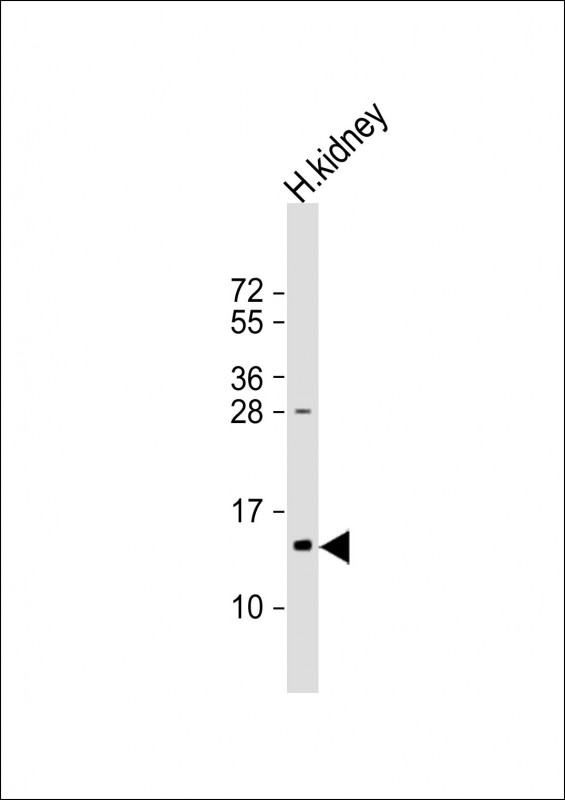

| WB | 1/1000 | Human,Mouse,Rat |
| IF | 咨询技术 | Human,Mouse,Rat |
| IHC | 咨询技术 | Human,Mouse,Rat |
| ICC | 技术咨询 | Human,Mouse,Rat |
| FCM | 咨询技术 | Human,Mouse,Rat |
| Elisa | 咨询技术 | Human,Mouse,Rat |
| Aliases | Transmembrane inner ear expressed protein, TMIE |
| Entrez GeneID | 259236 |
| WB Predicted band size | 17.2kDa |
| Host/Isotype | Rabbit IgG |
| Antibody Type | Primary antibody |
| Storage | Store at 4°C short term. Aliquot and store at -20°C long term. Avoid freeze/thaw cycles. |
| Species Reactivity | Human, Mouse |
| Immunogen | This TMIE antibody is generated from rabbits immunized with a KLH conjugated synthetic peptide between 71-100 amino acids from the Central region of human TMIE. |
| Formulation | Purified antibody in PBS with 0.05% sodium azide. |
+ +
以下是3篇与TMIE抗体相关的参考文献示例(注:部分信息为示例性概括,实际文献需通过数据库核实):
---
1. **文献名称**:*TMIE is essential for mechanoelectrical transduction in auditory hair cells*
**作者**:Zubair M. Ahmed, Saima Riazuddin, et al.
**摘要**:该研究通过免疫荧光和Western blot技术,利用特异性TMIE抗体证实了TMIE蛋白在小鼠耳蜗毛细胞中的定位,并揭示其在听觉机械电转导中的关键作用。突变导致TMIE功能丧失,引发先天性耳聋。
2. **文献名称**:*A novel anti-TMIE antibody reveals dynamic expression patterns during inner ear development*
**作者**:Karen P. Steel, et al.
**摘要**:研究团队开发了一种高特异性TMIE多克隆抗体,通过免疫组化分析显示TMIE在斑马鱼和小鼠内耳发育阶段的动态表达,提示其在毛细胞分化和成熟中的调控作用。
3. **文献名称**:*Genetic and functional analysis of TMIE mutations in nonsyndromic hearing loss*
**作者**:Xiaohan Wang, Tao Yang, et al.
**摘要**:该研究利用TMIE抗体进行蛋白表达水平检测,发现人类TMIE突变体导致蛋白稳定性下降,并通过小鼠模型验证了其与听力损失的关联机制。
---
**建议**:
如需获取真实文献,可通过PubMed或Google Scholar搜索关键词“TMIE antibody”、“TMIE hearing loss”或结合上述作者名,以查找相关研究。
The transmembrane inner ear (TMIE) protein is a critical component of the mechanotransduction machinery in sensory hair cells of the inner ear, playing a vital role in converting sound waves and head movements into electrical signals. First identified through genetic studies linking TMIE mutations to autosomal recessive nonsyndromic hearing loss (DFNB6 and DFNA36), this small, evolutionarily conserved protein localizes to stereocilia tips and is essential for forming functional mechanoelectrical transduction (MET) channels. TMIE interacts with other MET complex components, such as TMC1/2 and PCDH15. to regulate channel gating and ion permeability.
Antibodies targeting TMIE have become indispensable tools for investigating auditory physiology and pathology. They enable visualization of TMIE expression patterns in hair cells via immunofluorescence and assess protein levels in tissue lysates using Western blotting. Such studies have revealed TMIE’s dynamic expression during hair cell development and its disruption in genetic or noise-induced hearing loss models. Additionally, TMIE antibodies aid in characterizing transgenic animal models (e.g., Tmie knockout mice) that exhibit profound deafness and vestibular dysfunction, mirroring human phenotypes. Recent research also explores TMIE’s potential role in MET complex assembly and its interactions with therapeutic agents, positioning these antibodies as key reagents for advancing hearing restoration strategies, including gene therapy and molecular interventions.
×